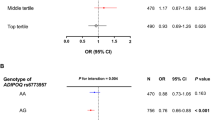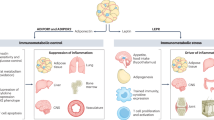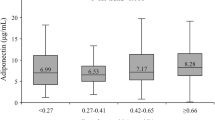Abstract
Recent evidence suggests a role for adipose derived cytokines (adipocytokines) such as tumor necrosis factor-α (TNF-α), IL-6, and the recently discovered adiponectin in the mechanism of impaired glucose regulation and atherosclerosis in adults. However, the relationship between adipocytokines and body composition, fasting insulin, and fitness is virtually unknown children. Fasting blood sampling was performed in 30 healthy, predominately Hispanic- and Asian-American children (16 boys, mean age 12.7 ± 0.1 y old) from a lower socioeconomic area in Los Angeles. Adiposity was measured by dual x-ray absorptiometry (DEXA); and peak oxygen uptake using cycle ergometry. Adiponectin (mean 10.8 ± 0.8 μg/mL) was inversely correlated with body mass index (BMI, as percentile by age) (r = −0.48, p = 0.011) and fat mass (r = −0.43, p = 0.03). In contrast, TNF-α and IL-6 were both positively correlated with BMI and fat mass. Adiponectin was inversely correlated with fasting insulin (r = −0.52, p = 0.006), but no correlations were found for insulin and either TNF-α or IL-6. Adiponectin was correlated with HDL (r = 0.448, p = 0.019). Paradoxically, peak oxygen consumption (an indicator of fitness) was negatively correlated with adiponectin levels (r = −0.471, p = 0.013) and positively correlated with TNF-α (r = 0.560, p = 0.002). In children, adipocytokines are correlated with fat mass, insulin sensitivity, and cardiovascular risk factors in a manner that is qualitatively similar to relationships recently observed in adults. In more obese children, the mass of fat tissue may attenuate potentially positive effects of fitness on circulating levels of adiponectin and TNF-α. The novel data on adiponectin suggest that deleterious dysregulation of adipocytokines associated with obesity may occur relatively early in life.
Similar content being viewed by others
Log in or create a free account to read this content
Gain free access to this article, as well as selected content from this journal and more on nature.com
or
Abbreviations
- TNF-α:
-
tumor necrosis factor-α
- DEXA:
-
dual x-ray absorptiometry
- BMI:
-
body mass index
- V˙o2:
-
oxygen consumption
References
Mossberg HO 1989 40-year follow-up of overweight children. Lancet 2: 491–493
Pinhas-Hamiel O, Zeitler P 1998 Type 2 diabetes in adolescents, no longer rare. Pediatr Rev 19: 434–435
Trayhurn P, Beattie JH 2001 Physiological role of adipose tissue: white adipose tissue as an endocrine and secretory organ. Proc Nutr Soc 60: 329–339
Maeda K, Okubo K, Shimomura I, Funahashi T, Matsuzawa Y, Matsubara K 1996 cDNA cloning and expression of a novel adipose specific collagen-like factor, apM1 (AdiPose Most abundant Gene transcript 1). Biochem Biophys Res Commun 221: 286–289
Arita Y, Kihara S, Ouchi N, Takahashi M, Maeda K, Miyagawa J, Hotta K, Shimomura I, Nakamura T, Miyaoka K, Kuriyama H, Nishida M, Yamashita S, Okubo K, Matsubara K, Muraguchi M, Ohmoto Y, Funahashi T, Matsuzawa Y 1999 Paradoxical decrease of an adipose-specific protein, adiponectin, in obesity. Biochem Biophys Res Commun 257: 79–83
Maeda N, Takahashi M, Funahashi T, Kihara S, Nishizawa H, Kishida K, Nagaretani H, Matsuda M, Komuro R, Ouchi N, Kuriyama H, Hotta K, Nakamura T, Shimomura I, Matsuzawa Y 2001 PPA Rgamma ligands increase expression and plasma concentrations of adiponectin, an adipose-derived protein. Diabetes 50: 2094–2099
De Spiegelaere M, Dramaix M, Hennart P 1998 The influence of socioeconomic status on the incidence and evolution of obesity during early adolescence. Int J Obes Relat Metab Disord 22: 268–274
Kuczmarski RJ, Ogden CL, Grummer-Strawn LM, Flegal KM, Guo SS, Wei R, Mei Z, Curtin LR, Roche AF, Johnson CL 2000 CDC Growth Charts: United States. Centers for Disease Control Prevention/National Center for Health Statistics Advance Data 314: 1–28
Beaver WL, Lamarra N, Wasserman K 1981 Breath-by-breath measurement of true alveolar gas exchange. J Appl Physiol 51: 1662–1675
Cooper DM, Weiler-Ravell D, Whipp BJ, Wasserman K 1984 Aerobic parameters of exercise as a function of body size during growth in children. J Appl Physiol 56: 628–634
Weyer C, Funahashi T, Tanaka S, Hotta K, Matsuzawa Y, Pratley RE, Tataranni PA 2001 Hypoadiponectinemia in obesity and type 2 diabetes: close association with insulin resistance and hyperinsulinemia. J Clin Endocrinol Metab 86: 1930–1935
Yudkin JS, Kumari M, Humphries SE, Mohamed-Ali V 2000 Inflammation, obesity, stress and coronary heart disease: is interleukin-6 the link?. Atherosclerosis 148: 209–214
Shimabukuro M, Zhou YT, Levi M, Unger RH 1998 Fatty acid-induced beta cell apoptosis: a link between obesity and diabetes. Proc Natl Acad Sci U S A 95: 2498–2502
Zinman B, Hanley AJ, Harris SB, Kwan J, Fantus IG 1999 Circulating tumor necrosis factor-alpha concentrations in a native Canadian population with high rates of type 2 diabetes mellitus. J Clin Endocrinol Metab 84: 272–278
Yamauchi T, Kamon J, Waki H, Terauchi Y, Kubota N, Hara K, Mori Y, Ide T, Murakami K, Tsuboyama-Kasaoka N, Ezaki O, Akanuma Y, Gavrilova O, Vinson C, Reitman ML, Kagechika H, Shudo K, Yoda M, Nakano Y, Tobe K, Nagai R, Kimura S, Tomita M, Froguel P, Kadowaki T 2001 The fat-derived hormone adiponectin reverses insulin resistance associated with both lipoatrophy and obesity. Nat Med 7: 941–946
McGill HC, McMahan CA, Herderick EE, Malcom GT, Tracy RE, Strong JP 2000 Origin of atherosclerosis in childhood and adolescence. Am J Clin Nutr 72: 1307S–1315S
Ouchi N, Kihara S, Arita Y, Maeda K, Kuriyama H, Okamoto Y, Hotta K, Nishida M, Takahashi M, Nakamura T, Yamashita S, Funahashi T, Matsuzawa Y 1999 Novel modulator for endothelial adhesion molecules: adipocyte-derived plasma protein adiponectin. Circulation 100: 2473–2476
Ouchi N, Kihara S, Arita Y, Okamoto Y, Maeda K, Kuriyama H, Hotta K, Nishida M, Takahashi M, Muraguchi M, Ohmoto Y, Nakamura T, Yamashita S, Funahashi T, Matsuzawa Y 2000 Adiponectin, an adipocyte-derived plasma protein, inhibits endothelial NF-kappaB signaling through a cAMP-dependent pathway. Circulation 102: 1296–1301
Ouchi N, Kihara S, Arita Y, Nishida M, Matsuyama A, Okamoto Y, Ishigami M, Kuriyama H, Kishida K, Nishizawa H, Hotta K, Muraguchi M, Ohmoto Y, Yamashita S, Funahashi T, Matsuzawa Y 2001 Adipocyte-derived plasma protein, adiponectin, suppresses lipid accumulation and class A scavenger receptor expression in human monocyte-derived macrophages. Circulation 103: 1057–1063
Kappes A, Loffler G 2000 Influences of ionomycin, dibutyryl-cycloAMP and tumour necrosis factor-alpha on intracellular amount and secretion of apM1 in differentiating primary human preadipocytes. Horm Metab Res 32: 548–554
Eliakim A, Burke G, Cooper DM 1997 Fitness fatness and the effect of training assessed by magnetic resonance imaging and skinfold measurements in healthy adolescent females. Am J Clin Nutr 66: 223–231
Poehlman ET, Dvorak RV, DeNino WF, Brochu M, Ades PA 2000 Effects of resistance training and endurance training on insulin sensitivity in nonobese, young women: a controlled randomized trial. J Clin Endocrinol Metab 85: 2463–2468
Eriksson J, Tuominen J, Valle T, Sundberg S, Sovijarvi A, Lindholm H, Tuomilehto J, Koivisto V 1998 Aerobic endurance exercise or circuit-type resistance training for individuals with impaired glucose tolerance?. Horm Metab Res 30: 37–41
Cox JH, Cortright RN, Dohm GL, Houmard JA 1999 Effect of aging on response to exercise training in humans: skeletal muscle GLUT-4 and insulin sensitivity. J Appl Physiol 86: 2019–2025
Nicholson JF, Pesce MA 2000 Reference Ranges for Laboratory Tests and Procedures—Part I. In: Behrman RE, Kliegman RM, Jenson HB (eds) Nelson Textbook of Pediatrics. WB Saunders, Philadelphia, pp 2184–2222.
Krafte-Jacobs B, Bock GH 1996 Circulating erythropoietin and interleukin-6 concentrations increase in critically ill children with sepsis and septic shock. Crit Care Med 24: 1455–1459
Nemet D, Oh Y, Kim HS, Hill MA, Cooper DM 2002 The effect of intense exercise on inflammatory cyotkines and growth mediators in adolescent boys. Pediatrics 110: 681–689
Scheett TP, Nemet D, Stoppani J, Maresh CM, Newcomb R, Cooper DM 2002 The effect of endurance-type exercise training on growth mediators and inflammatory cytokines in pre-and early pubertal males. Pediatr Res 52: 491–497
Scheett TP, Milles PJ, Ziegler MG, Stoppani J, Cooper DM 1999 Effect of exercise on cytokines and growth mediators in prepubertal children. Pediatr Res 46: 429–434
Sack U, Burkhardt U, Borte M, Schadlich H, Berg K, Emmrich F 1998 Age-dependent levels of select immunological mediators in sera of healthy children. Clin Diagn Lab Immunol 5: 28–32
Visser M, Bouter LM, McQuillan GM, Wener MH, Harris TB 2001 Low-grade systemic inflammation in overweight children. Pediatrics 107: E13
Author information
Authors and Affiliations
Corresponding author
Additional information
Supported by grants MO1-RR00827 and HD 23969 from the National Institutes of Health. D.N. is a Postdoctoral Research Fellow of the Joseph W. Drown Foundation.
Rights and permissions
About this article
Cite this article
Nemet, D., Wang, P., Funahashi, T. et al. Adipocytokines, Body Composition, and Fitness in Children. Pediatr Res 53, 148–152 (2003). https://doi.org/10.1203/00006450-200301000-00025
Received:
Accepted:
Issue date:
DOI: https://doi.org/10.1203/00006450-200301000-00025
This article is cited by
-
Association between maternal polycystic ovary syndrome and early childhood growth: a continuous observation from 3 months to 6 years of age
Journal of Assisted Reproduction and Genetics (2022)
-
Independent and combined associations of physical fitness components with inflammatory biomarkers in children and adolescents
Pediatric Research (2018)
-
SAA1 gene variants and childhood obesity in China
Lipids in Health and Disease (2013)
-
Cardiovascular disease in childhood: the role of obesity
European Journal of Pediatrics (2013)
-
Inflammatory and Prothrombotic States in Obese Children of European Descent
Obesity (2012)



